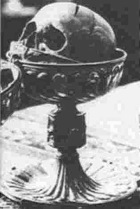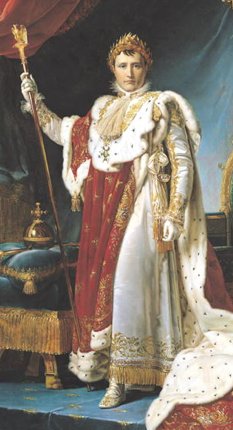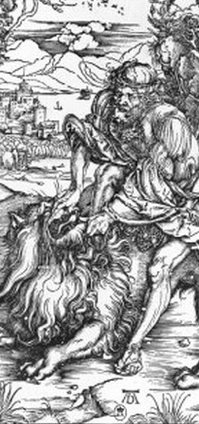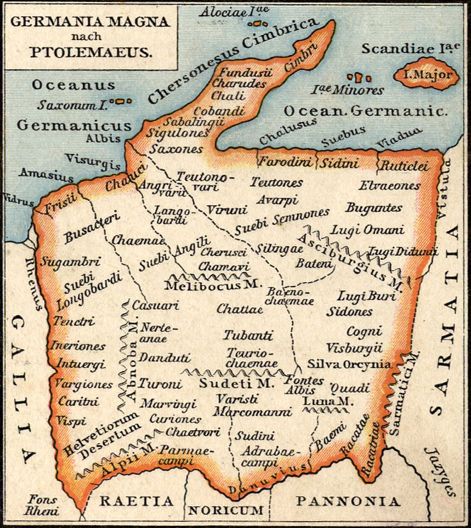The Franks
The Franks first crossed the Rhine into Gaul from Germania as early as
the first century A.D. in raids, crossing for good finally in the 4th
century. The Franks were actually a confederation of Germanic
tribes which included the Salii, Sicambri, Chatti, Batavi and Tencteri
(see
notes at bottom of page), and from the Salii (better known as the
Salian
Franks) rose a great line of kings, the Merovingians, who united Gaul.
There is no doubt in my mind that the Franks represented an important
branch of
the "dragon" tree. Merovech, for who the royal Merovingian line
was named and whose grandson
Clovis united nearly all of Gaul under Frankish
rule, was said to be the son of a sea-monster. Before they moved
inland into Gaul, the Frankish tribes harrassed the English Channel as
pirates, and there is also
evidence of biblical Levant influence in Frankish culture, which I'll
get
to. The
Franks never gained quite the bad reputation earned by the Vikings,
and were in fact sometimes the victims of Norse raids into Gaul, but
the
Merovingian kings of the early Frankish
kingdom were a pretty violent lot.

|
Trepanned
skull of Dagobert II
|
One of the first Merovingians,
a king named Chlodio, killed his brother-in-law to secure his
throne. Next Merovech and his half brother Cloderic warred
bitterly (though neither of them were able to kill the other), Clotaire
I killed (or I should say, had killed) all of his brother Clodomir's
sons, and his grandson Clotaire II murdered Sigebert II. Dagobert
I had
both his half-brother Charibert and Charibert's son Chilperic
murdered, and Dagobert II, one of the last Merovingians, was killed by
a
god-son.
As it turns out, the
Franks and the Vikings may have been cousins who both migrated
to northern Europe from the northern shores of the Black Sea, i.e.
Scythia, roughly around the same time.
In their own mythology the Franks traced their origins to the
Cimmerians through a proto-Frank peoples called
the Sicambrians. If various genalogy sites and the records and
legends they
derive from are to be trusted, these Cimmerians in turn were descended
from Trojans.
Antenor
I, Euxim of the Cimmerians
Marcomir, King of the Cimmerians
Antenor II, King of the Sicambri
Priamus, King of the Sicambri
Helenus I, King of the Sicambri
Diocles, King of the Sicambri
Bassanus Magnus,
King of the Sicambri
Clodomir I, King of the Sicambri
Nicanor, King of the Sicambri
Marcomir II, King of the Sicambri
Clodius, King of the Sicambri
Antenor III, King of the Sicambri
Clodomir II, King of the Sicambri
Merodachus, King of the Sicambri
Cassander, King of the Sicambri
Antharius, King of the SIcambri
Francus, King of the Franks
Clodius II, King of the Franks
Marcomir III, King of the Franks
Clodomir III, King of the Franks
Antenor IV, King of the Franks
Ratherius, King of the Franks
Richemer I, King of the Franks
Odomar, King of the Franks
Marcomir IV, King of the Franks
Pharabert, King of the Franks
Sunno, King of the Franks
Hilderic, King of the Franks
Bartherus, King of the Franks
Clodius III, King of the Franks
Walter, King of the Franks
Dagobert I, King of the Franks
Genebald I, Duke of the East Franks
Dagobert II, Duke of the East Franks
Clodius IV, Duke of the East Franks
Marcomir V, Duke of the East Franks
Pharamond, King of All Franks
Clodio, King of the Franks
Merovich, King of the Salian Franks
Childeric I, King of the Salian Franks
Clovis the Great,
King of All the Franks
|
The 'Liber Historiae Francorum' connects the Sicambrians straight to
the Tojans in a fashion, stating that after the fall of Troy 12,000
Trojans led by chiefs Priam and Antenor migrated to the Tanais (Don)
river and founded a city called Sicambria near the Sea of Azov, which
would have put them in close proximity to the proto-Viking tribe of
Aesir. Other accounts have the ancestors of the Franks living in
Pannonia (according to Strabo) or the Black Sea mouth of the Danube
(Chronicle of Fredegar). So, where they lived exactly, if they
all lived together (which, given the many tribes which became the
Franks, they probably didn't), is unclear.
The genealogy shown at the right, courtesy of Ray Oliver, was prepared
for a regent of France and further corrected and augmented at the
behest of Napolean
I, who wanted to know the ancestry of the Merovingians. It begins
with Antenor I Euxim of the Cimmerians (
b. 465 A.D.; d. 511 A.D.) and traces through to the French kings of the
14th century. Shown at right is the list up to Clovis (b. 465
A.D.; d. 511 A.D.).
Napoleon was seemingly quite obsessed with the Merovingians, he had 300
gold bees sewn into his emperial robe which had been dug up along with
the remains of Childeric I in 1653.

|
Napoeon
in his bee-embroidered cloak
|
From the fact that Childeric I had himself buried with a colony of
golden bees, one can infer that the bee held special meaning for the
Merovingians. Indeed it did, and the
reason should be obvious, for bees live in a
heirarchical society where
workers and soldiers feed and protect a queen. The
hexagon
shape of hive-cells is chosen by
nature in other instances as well (snowflakes, embryonic cell-division)
for its economy and strength and is an important form in "Sacred
Geometry". Additionally, the
interlocking triangles of
the 6
pointed star we know as the
Magen-David (which actually is a pagan symbol and is very old) create a
hexagram in its
center. One author writes:
"The Merovingian
kings were noted sorcerors in the manner of the Samaritan Magi, and
they firmly believed in the hidden powers of the honeycomb. Because a
honeycomb is naturally made up of hexagonal prisms, it was considered
by philosophers to be the manifestation of divine harmony in nature."

|
Samson
killing the Lion
|
There is a figure from the bible also associated with bees ... Samson,
whose father was of the Tribe of Dan. One well known legend of
Samson revolves around a lion he killed and the bees that infested the
carcass. He falls in love with a Philistine woman and poses a
riddle to her countrymen, "Out of the eater, something to eat; out of
the strong, something sweet" (the answer to the riddle being that the
lion - the "eater" - is slain and eaten, while the bees that infest the
carcass produce honey, "something sweet").
The association of bees with both Samson and the Merovingian Kings is
probably not a coincidence. Samson gained his strength from his
long hair, while the Merovingians were known as the "long-haired
monarchs". Furthurmore one of the sons of Chilperic I was
named
Samson. If you accept that the Franks and Vikings split
off from the same
branch and shared a Trojan history, then one can imagine how the story
of Samson might have been absorbed into Frankish mythology.
The Greek myth-writers had Ilyus, the founder of Troy, being descended
from Dardanus, the first of the line of future Kings of Troy to arrive
in the region (as per myth). In addition to Dadanus though, there
was also a Danaus of Greek mythology as well as a Darda of the bible,
all three of whom correlate in interesting and profound
ways. Sorting it out is a bit complicated and since I don't
want to get sidetracked too far away from the topic of the Franks I
will set it aside for a future post (to be titled Coat of Vlad), but
what the clues tell us that the kings of the proto-Israelites in Egypt
and the kings of the proto-Trojans who would later rule over the
Vikings and the Franks in northern Europe were in fact the same line of
kings, themselves descended from Hyskos invaders of the Levant.
Biblical genealogy tells the same story, though without labeling the
proto-Israelites in Egypt as Hyksos or following the branch of the
thread which split off from there and migrated to Greece and Anatolia
... but the Greek myths did record this branch, and the correlations I
mentioned (and will describe in detail in another post) allow us to put
the pieces of
the puzzle back together in a fairly satisfying way.
If the Frankish Merovingian kings were (or believed themselves to be)
descended from the same line of kings as the Israelites, then it puts a
whole new spin on the "Magdalene Heresy", that is, the allegations at
the heart of Henry Lincoln's (and two other writers') book 'Holy Blood
Holy Grail', which provided the seed for the wildly successful 'DaVinci
Code' by Dan Brown and the film which it spawned. And,
there's another instance in history of a merging of Frankish and
Israelite blood, this time intentional and far less speculative than
what the Merovingians advertised.
'Holy Blood Holy
Grail' from where Brown got many of his ideas revolves around the
premise that the Merovingian kings were vessels of the blood of Christ
- that Mary
Magdalene was pregnant with Jesus' child at the time of Christ's death
and fled to the south of France, and that that blood somehow found its
way into what would become the Merovingian line. I won't try to
prove or disprove that, I would guess it would be
near-impossible. But, there are numerous clues from the
bible which suggest that Mary and Jesus were in fact married ... the
timing of certain events described in the bible in which Jesus and Mary
participated coincide exactly with the ceremony prescribed for a
betrothed Judaic priest ... but
the salient point is not what is true or not true, but simply that the
Merovingians advertised this alleged connection to Mary of Magdala, and
by
extension the Davidic kings of Palestine.
Why? ... To strengthen the Merovingian claim of demi-god status.
Jesus and (his alleged wife) Mary of Magdala were both priests ...
royalty of the line of Davidic priest-kings stretching back to the
Hyksos
kings of Egypt, as was John the Baptist. John was known as the
"Great Nazar", while Jesus is referred to as being "of Nazareth".
This doesn't mean he was born in Nazareth, it means he was a
Nazarite.
Michael Tsarion lists the following terms as meaning serpent or dragon
in various dialects.
Mayan
---- Nachan
Irish ------- Nathair (Nathrach, Nadder, Naase)
German --- Natter
Cornish ---- Nader
Gothic - ----Nadr
Latin -------Natrix
So,it appears that what was really being said when John was referred
to as the Great Nazar or when Jesus was referred to as a Nazarite, was
that they were both kings of the ancient line, i.e.
dragon-priests. The word Messiah, some believe, derives from
Messeh, which was the holy
Egyptian crocodile, the fat of which was used to annoint Egptian
Pharaohs.

|
| rod
of Asclepius |
Some may not be ready for that, but take heart, the dragon was not
always an ominous creature which storybook heroes were trying to slay
all the time ... it was simply the sign of royalty and in fact
possessed life-giving powers. An artifact of this aspect of
the dragon/serpent is that the official emblem of the medical
profession to this day is the rod of Asclepius, entwined by a snake
(often confused with the staff of Hermes or caduceus which has two
snakes wrapped around it).
More is known about another attempt to infuse the Frankish royal line
with blood from the Jewish branch of Palestine ... when Charlemagne,
the greatest Frankish king of all time, specifically appealed to the
Caliph of Baghdad to send to France "seed" of the Davidic line of
kings.
Preserved by Abraham ibn Daud in his Sefer ha-Qabbalah, written about
1161 A.D.:
"Then King
Charles sent to the King of Baghdad [Caliph] requesting that he
dispatch one of his Jews of the seed
of royalty of the House of David. He hearkened and sent him one from
there, a magnate and sage, Rabbi Makhir by name. And [Charles] settled
him in Narbonne, the capital city, and planted him there, and gave him
a great possession there at the time he captured it from the
Ishmaelites [Arabs]. And he [Makhir] took to wife a woman from among
the magnates of the town; *...* and the King made him a nobleman and
designed, out of love for [Makhir], good statutes for the benefit of
all the Jews dwelling in the city, as is written and sealed in a Latin
charter; and the seal of the King therein [bears] his name Carolus; and
it is in their possession at the present time. The Prince Makhir became
chieftain there. He and his descendants were close [inter-related] with
the King and all his descendants."
|
So the Caliph sent him Rabbi Makhir, seed of the Davidic line of
Israelite kings, who Charlemagne showered
with title and lands in the Languedoc region of southern France - and a
Frankish wife to boot.
To understand why Charlemagne might have done this, some background is
necessary. Charlemagne was one of the first Frankish kings of the
Carolingian line, which displaced the Merovingians in the 8th
century. The Merovingians had never gotten along so well with
the Church of Rome, even though they had officially been Christian
since the time of Clovis. One of the problems was, the
Merovingians honored the concept of blood descent, while
the Catholic Church practiced Apostolistic decent whereby bishops and
popes were "ordained". (Personally I think the animosity between
the Merovingians and the Church was more deeply seated, having to do
more
with the waring history of the "barbarians" identifiable with the
dragon cult which overwhelmed the Roman Empire in
Gaul). Whatever the case, following a string of weak
Merovingian
kings the Catholic Church managed to supplant the Merovingians in
France with their own governmental 'Mayors', and one of these, Charles
"the Hammer" became the first Frank King of the new Carolingian
line.
The Carolingians were actually connected by blood to the Merovingians
before them, but just by a thread (a disputed connection through
Bertrada "broadfoot"). This is mainly why (I
believe) Charlemagne appealed to the Caliph of Bagdad to send him some
royal Egyptian/Jewish blood ... to strengthen the Carolingian claim of
dragon descent, thereby their divine right to rule.
Rabbi Makhir apparently took a Carolingian wife (Aldana or Aude,
probably the
daughter of Charles Martel) after moving to France, and
many believe that he assumed the Frankish name Theoderic - which would
make him the father of Guillaum (William) of Gellone and Bertha of
Autun - whose blood in
turn flowed generously into the noble French houses of Toulouse,
Aquitaine, Anjou,
and Lusignan. (I have prepared a simple genealogy tree which can
be found farther down this post.) Guillaume and Bertha's prolifacy is
well
documented but their parentage is not, and whether their father was
Theoderic IV or Rabbi Makhir or both is very controversial.
I suspect Makhir was their father however, for the dissemination of
Makhir's blood into the several
Frankish noble houses would have served Charlemagne's intention, to
infuse the Frankish nobility with a booster shot of royal Israelite
blood, or, if Charlemagne was aware of the Trojan roots of the Franks
(hard to believe he didn't since the capital of Champagne was Troyes),
to re-unite the Trojan-Frank and Israelite branches of the
dragon which, if all of the above is believable, split off from one
another
in Egypt. Remember,
Charlemagne made a request for "seed"
of the Davidic line, not unlike an
American dog breeder who sends to England for a Cavalier King Charles
Spaniel to refresh the breed.
In addition to royal blood, Rabbi Makhir brought with him the teachings
of Kabbalah, which spread throughout the Languedoc and into nearby
Toulouse and Aquitaine as Catharism.
The Templar Knights are also thought to have been Cathars. This
"heretical"
religious sect was largely stamped out violently by the Catholic Church
during the Albigensian Crusade, but there's good evidence that
Catharism and "courtly love" continued to be embraced to some extent by
the Counts of Toulouse and the Dukes of Aquitaine ... William IX of
Aquitaine is even known as "the Troubador" (romantic song-singing was
a hallmark of Catharism). These noble houses
as
well as the house of Lusignan, Fulks of Anjou and Dukes of Brittany not
only all trace back to Guillaume and Bertha, they intermarried amongst
one another and with the Norman line of William the Conqueror.
The
result was a blood-alliance of Frankish Counts, Dukes and Fulks that
fought
alongside
the Templars in the Holy Land during the Crusades.
Below is a simplified genealogy chart beginning with Merovech the
grandfather of Clovis I, moving through the Merovingian kings and
into the Carolingians and Charlemagne. From the Carolingians
links to Guillaume of
Gellone and Bertha of Autun (and their father Theoderic IV/Rabbi Makir
(?)) and the house of Lusignan, the Dukes of Aquitaine and Brittany,
the Counts of Toulouse and the Fulks of Anjou are shown, and on the far
right at the bottom you can see where the Dukes of Normandy and
William the Conqueror initially fit in. These houses
further intermarry with the royal Normans of England as history moves
forward, and there is more intermarrying between the houses that I
could practically show (without the chart becoming an unreadable mess)
- in
other words, this chart is simplified and only shows important persons
and marriages necessary to get the point across.
To open in a separate window:
frank_genealogy.html
Historians, scholars, and the stories of the world we are taught in
schools all identify a myriad of peoples and tribes who each played
minor roles in shaping the world we live in ... but I wonder if the
true elite, the keepers of secret knowlege, the few who are hip to what
the Greek myths and the stories in the bible and other religious texts
are actually coded records of, don't see instead a much simpler version
of human history, a tree of several branches representing their
anscestors which split and reconnect at various times in
history. If, as I suspect, the ancestors, culturally if not
in blood to some degree, of the Vikings and the Franks really shared a
history with the proto-Israelites in Egypt, then is it any wonder that
the pyramid found its way onto the Great Seal of the United States (and
the reverse side of the current US Dollar)? Or that Egyptian
obalisks decorate the centers of Washington and London (there's one in
Rome too, brought back from Egypt by Alexander the Great)?
(P.S. - shhh, don't tell your
mother - these obalisks really represent the penis of Osiris, which was
lost after Seth
cut him up into 14 pieces. Isis with the help of other dieties
found all but one of them and reassembled the body of her companion,
but his genitals had been eaten by a
fish. THAT's what the Washington monument represents, the lost
penis of Osiris ... in case you
didn't know. :D)
Final notes:
There are plenty of historians who are skeptical that Guillaum of
Gellone and
Bertha of Autun, whose blood flowed all over the place among the noble
houses of France through their descendants, were really the children of
Rabbi Makhir and Auda ... but if they weren't, why did
Charlemagne go to all the trouble? Why go
out of his way to coax a Jewish rabbi to move
to France with offers of vast lands and title, and then chose for him a
bride from his own family?
I have to tell you, in all the research I've done, irretractable
controversy always seems to spring up around critical figures like
Rabbi Makhir, fulcrums upon which the real story of the ruling elite
hinge. I know I'll sound like a nut-job "conspiracy theorist" for
saying this (author giggles to himself), but it's as if there's a dirty
secret out there that us peons aren't supposed to get wise to.
Seriously, every time there is a marriage in history which may or may
not be especially significant regarding the merging of branches of what
I call the dragon blood-line, and seemingly only when such a marriage holds
such special significance, it is surrounded by century-old
controversy.
Personally, I'm inclined to believe that Charlemagne had a very good
reason for importing royal Israelite blood to France, and that his goal
was fulfulled ... and, that the repercussions of Makhir's becoming the
husband of a Frank and the father of a Religious movement still
reverberate to this day.
But this is all just a taste of what comes next ... for major branches
of the dragon would soon meet again. While Catharism was
speading throughout southern France, northern France was getting the
s#&t kicked out of it by Rollo and his Viking
invaders. Charlemagne made peace with Rollo by granting him the
lands of Normandy - and, a Frankish wife to boot, Popa of Valois.
Suddenly the Viking and Frank branches of the dragon were reunited as
well.
Which is almost as significant as yet one other marriage between a
Viking named Inger and a Byzantine princess, after which a veritable
orgy of intermarrying between royal Hun, Frank, Viking and Khazar
blood-lines would erupt, resulting in the aristocracy of the eastern
half of Europe to where power shifted following the heayday of the
Carolingian Franks.
The Byzantine princess in question was a girl named - Melissena ...
Notes on
the original federation of Frankish
tribes
I find Wikipedia fairly useful as long as the topic isn't too
controversial, and the identity of the tribes that coalesced into the
Franks isn't exactly a hot topic (giggle). Wikipedia lists
them as Salii, Sicambri, Chamavi, Bructeri, Chatti, Chattuarii,
Ampsivarii, Tencteri, Ubii and Batavi.
I list these because many of these names pop up from time to time in an
online book titled 'Tracking Ladon Gog and the Hebrew Rose'. The
writer, who identifies himself only as "John", is a certifiable genius
in my opinion with regard to tracing the origins of the ruling elite.
I highly recommend John's book for anyone truly interested in
this subject, though I should warn that Ladon Gog is not recreational
reading - personally I can only bite off one chapter at a time.
(I advise keeping a browser window open to search for maps of the
ancient world, genealogy trees and explanations of Greek myths so you
can keep up.)
http://www.tribwatch.com/ladon.htm
Below is a map of Germania produced in the 2nd century by
Ptolomy. A lot of insight can be drawn from looking over the
names of the tribes. It's a good bet the future Merovingians
lived toward the lower left of the map where the name 'Marvingi' can be
found.
Two names above Marvingi you find 'Danduti', a "Dan" name, and below
it is 'Curiones' which evokes the Curetes of Greece and the Cruithne of
Scotland, both connected to the Black Sea via the Grecian myth of the
Calydonian Boar Hunt (more about that in a second). The boar is,
to put it simply, the
trademark of the dragon-tribes of the Black Sea and connects
linguistically to Bayern (Bavaria), family names like Bauer (the
original name of the Rothschild family), Bower and Bayer. Bear,
also an animal you might kill with a bow and arrow, might also be
connected linquistically to bow and boar, but was not a symbol of the
peoples of the Black Sea - however the bear shows up on many Germanic
royal coats, and Albrecht Duke of Saxony 1st Margrave of Brandenburg
(whose son and grandson, Otto I and Otto II will appear in the next
post) is affectionately known as Albert "the Bear".

Three important family coats of arms that I am aware of feature a boar
- the Vere family
(heritary Earls of Oxford), the Bush family (the coat of arms of the
former US presidents features three
boars),
and the Pollock family. Pollock translates to "head of Lug" and
emerged from the Lugii or Lugi tribe. Toward the upper
right of the
above map you can find the Lugi Omani, Lugi Diduni and Lugi Buri.
There was a Lugi tribe in Scotland as well who settled in
Sutherland.
Wikipedia states that they are unrelated to the Lugii
of northern Europe. I beg to differ!
Links between Scotland and tribes of the Black Sea area, are
abundant. The Milesian invaders of Scotland are
represented in myth as Scythian with an Egyptian component (Mil is
represented as descended from Scythian kings while his wife Scota is
described as an Egyptian princess). The Greek myth of the
Calydonian
Boar Hunt indicates a connection as well, for Artemis central to the
myth is, like her twin brother Apollo, intimately connected with the
Trojan tribes of the Black Sea area, whereas Scotland was also known as
Calydonia. In addition to the boar, another animal often
associated with the tribes of the
Black Sea was the wolf, and it is no coincidence that Lugi is similar
to "wolf" terms such as Lykos and Lycanthrope
(werewolf). One of Apollo's epithets is 'Lykegenes', or 'of
the wolf'. Hence,
these tribes are sometimes referred to (by myself and others who
research this stuff at least) as 'wolf peoples'.
And what do we find on the Clan Badge of the Scottish Sutherland
family? A wolf.

|
| Sutherland
Clan Badge |
|
|